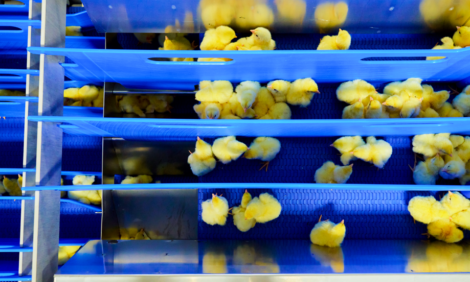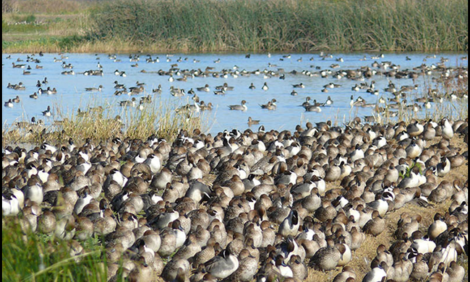



Various Countries Poultry Industry Overview
By the USDA FAS - This article provides the highlights and links to the 2003 USDA FAS Poultry and Products Annual reports for Argentina, Australia, Brazil, Canada, China, India, Japan, Kuwait, Malaysia, Mexico, Poland, Romania, Russian Federation, Saudi Arabia, South Africa, Taiwan and Venezuela.Argentina
Argentine poultry exports for 2004 are projected at 70,000 tons, almost twice as high as those in 2003. This record high is a result of Argentine products being very cost and quality competitive after the 2002 devaluation, and the heavy investment of the past several years. In addition from the current 32 markets to which Argentina already has access, new ones are expected to open. Foreign demand is expected to continue to be strong. Local broiler production is expected to increase significantly as returns in both the domestic and export markets are very good.
To read the full report please click here
Australia
Australian poultry production is forecast to continue growing from the record levels achieved in 2003/04. Production, however, has been constrained by reduced feed grain supplies and record high feed grain prices brought on by one of the worst droughts in a century. Exports amounted to only three percent of total production in 2002/03 making poultry a relatively unique industry within Australia's largely export orientated agricultural sector. Australian quarantine regulations prohibit the importation of fresh chicken meat.
To read the full report please click here
Brazil
Brazilian broiler production is projected to increase by 5 percent in 2004, driven mostly
by continued expansion of broiler exports, and, to a lesser extent, a rebound in
domestic consumption. Turkey production and exports are also projected to increase
in 2004.
To read the full report please click here
Canada
Present prospects point to lower Canadian production of chicken and turkey in 2003 from
year ago levels. The effects of Sudden Acute Respiratory Syndrome (SARS), which
dampened economic activity in the first half of the year, and the events surrounding the
discovery of Bovine Spongiform Encephalopathy (BSE), which increased domestic beef
supplies, contributed to the national poultry meat agencies setting conservative production
allocation levels, a development which is forecast to linger into 2004. In poultry meat trade, the value of U.S. poultry meat exports to Canada, in the first six months of 2003, is almost 10% above last year's pace.
To read the full report please click here
China
China's poultry imports during 2003 and 2004 are forecast to fall from last year due to SARS,
quarantine/certification requirements and the import ban on 7 U.S. States due to Avian
Influenza. Over the next couple of years, China’s poultry industry is not forecast to compete
with U.S. frozen broiler cuts in key export markets. However, China will increase exports of
highly processed cuts and cooked products. China's poultry meat production during 2004 is
forecast at 10.1 million MT, two percent above this year's level. The output increase is due
to a recovery in consumption following the end of SARS coupled with expectations that the
Japanese and EU export markets may reopen.
To read the full report please click here
India
India's broiler meat production is forecast to grow by 13 percent to 1.8 million tons in CY 2004 due to increasing demand, affordable prices for poultry meat, and anticipated better availability of feed materials. The expansion of integrated poultry operations is likely to help sustain high growth in meat production and also create an increasingly competitive and costconscious industry that will generate increased demand for corn.
To read the full report please click here
Japan
Japan’s total broiler consumption in 2004 is forecast to rise by 1% (to 1.85 million MT), while production is expected to ease by 1%. Imports are expected to increase by 6% (to 745,000 MT) in 2004. Imports in 2003 are expected to drop, reflecting imposition of a three-month import ban Chinese poultry due to the detection of Avian Influenza.
To read the full report please click here
Kuwait
In 2004, Kuwait boiler production is projected at 31,000 MT, with birds mostly marketed live. Frozen chicken imports are forecast at 73,000 MT. Brazil is expected to dominate the whole bird, bone-in and boneless parts markets. The U.S. should be competitive in the bone-in parts market. Demand in Iraq should continue to energize the re-export market, pushing exports of whole birds and leg quarters to the 3,000-4,000 MT level.
To read the full report please click here
Malaysia
The best prospect for U.S. Exporters appear to be in supplying dat-old chicks (DOC), broiler grandparent stock, frozen turkey/turkey parts and frozen chicken parts. There are also limited opportunities for sales of processed poultry meat. Joint-venture inverstments in the production of higher quality processed/deli meat mat also be an area worth exploring by U.S. business investors.
To read the full report please click here
Mexico
Mexico’s poultry industry is forecast to continue growing during MY 2004 (Jan- Dec) as the
trend toward vertical integration in the chicken industry continues. Exports of U.S. poultry
and poultry products are forecast to increase as well. The lifting of key technical
requirements on raw poultry for direct consumption should lend a boost to U.S. exports.
However, a recently signed safeguard agreement on chicken leg quarters is expected to keep
overall export growth in check. The final safeguard agreement was signed on July 25, 2003,
and will be in place through January 1, 2008.
To read the full report please click here
Poland
U.S. poultry meat exports to Poland will terminate late 2003 or early 2004 when Polish Veterinary Authorities implement EU import requirements. The exact date of implementation of the EU rules is not known. According to preliminary statements of Polish Veterinary Authorities, transhipment of U.S. poultry meat through Poland will be allowed after Poland’s EU accession in May 2004. Regulations regarding post EU accession transhipments have not been established yet. Meanwhile, it is expected that Poland’s chicken broiler production will increase six percent in 2003 and another four percent in 2004. Turkey meat production is expected to slightly increase or stabilize in 2003.
To read the full report please click here
Romania
A recovery in the Romanian Poultry industry is well underway. Domestic poultry production is expected to increase by 12% in 2003 and 10% in 2004, driven mainly increased demand and subsidies. Regarding U.S. exports to Romania, their value doubled in 2002 to over 16 million. For 2003, veterinary restrictions imposed on EU production, along with the
continued fall of the U.S. dollar, are the main factors to help United States become the leader supplier in 2003.
To read the full report please click here
Russian Federation
Russian broiler production is forecast to grow by ten percent in 2004, marking the seventh straight year of increased production and an over 300 percent increase since 1997. Investment and reconstruction of under performing plants continue to boost Russian production capacity. Russian imports in 2004 are forecast to decline by 11 percent due to the safeguard quota established in May 2003. The poultry quota and veterinary issues with several supplying countries are expected to also reduce Russian imports in 2003, by 12 percent from the previous estimate.
To read the full report please click here
Saudi Arabia
Local poultry production for 2004 is forecast at 530,000 metric tons, up by four percent from the 2002 level. Total poultry meat and products imports is expected to reach 395,000 metric tons next year.
To read the full report please click here
South Africa
South Africa’s broiler production is still growing with about 760,000 tons produced in 2002 and 790,000 tons expected to be produced in 2003. Meat imports amounted to a paltry 24,000 tons in 2002 although total poultry product imports exceeded 80,000 tons. Seventy percent of the total product imports consisted of offal and Mechanically Removed Meat (MRM). Although the by-product imports could hardly been seen as damaging the local industry, the producers have applied for anti-dumping protection. The application is still pending.
To read the full report please click here
Taiwan
Although consumption of poultry products has stagnated due to an overall lackluster
economy and diet diversification, the poultry products sector represents a significant area of opportunity for imports, as WTO-mandated market opening measures give US suppliers (who
generally enjoy a landed cost advantage against domestic producers) increasing access to
the nearly 637 thousand metric ton market for chicken meat and offal. Historically low
supplier prices for turkey have also helped turn around Taiwan demand for turkey meat,
largely used as protein filler in processed meat products. Extension of chicken meat sales
from current foodservice customers into the home prepared meal market will require a shift
in consumer perceptions toward acceptance of frozen chicken meat for home cooked meals.
To read the full report please click here
Venezuela
Venezuela’s poultry production is estimated to fall in 2003 due to lower demand and increased cost of feed ingredients. Consumption is also down due to the economic recession that the country is experiencing and falling disposable incomes. The Venezuelan government did import a small quantity of chicken from Brazil to meet short-term needs in its programs, but larger purchases are not expected. US poultry could be attractive in the market if importers are able to obtain SASA import permits.
To read the full report please click here
List of Articles in this series
Poultry and Products report for the European Union
Poultry and Products report for Indonesia
Source: USDA Foreign Agricultural Service - October 2003









